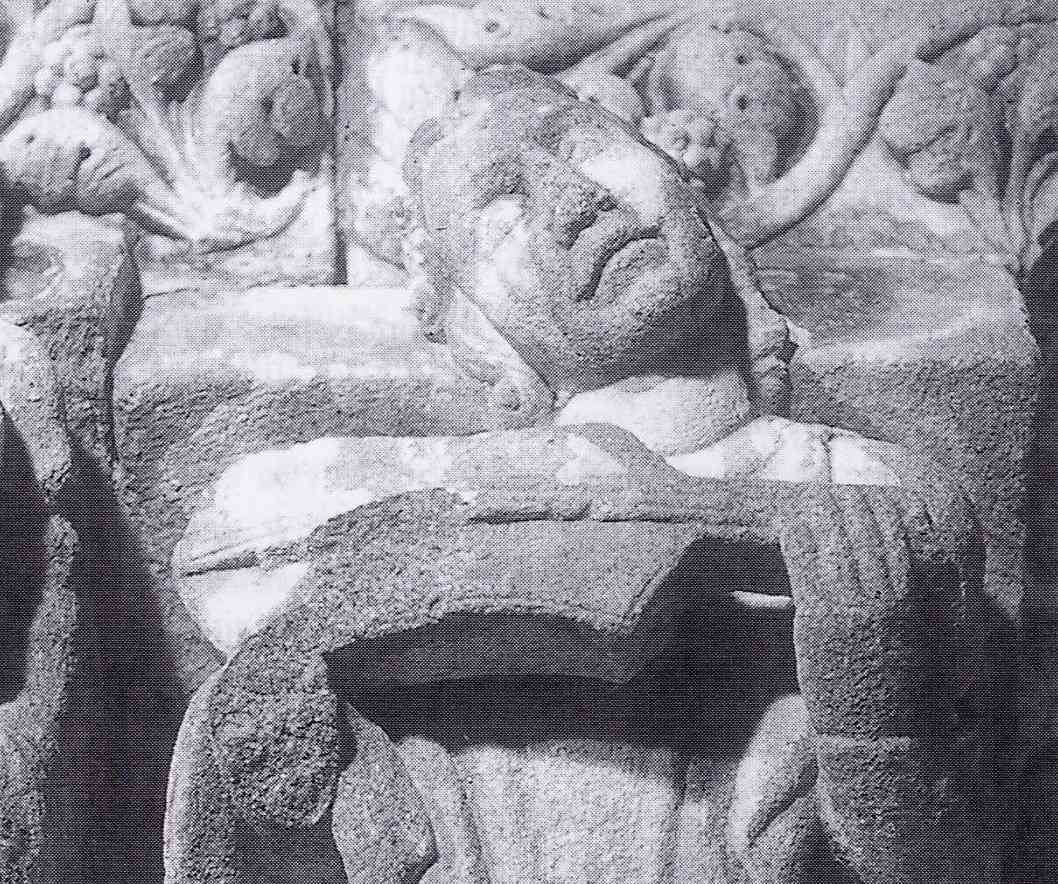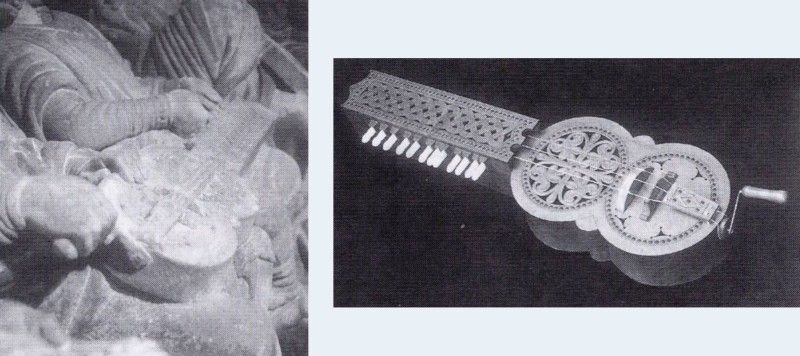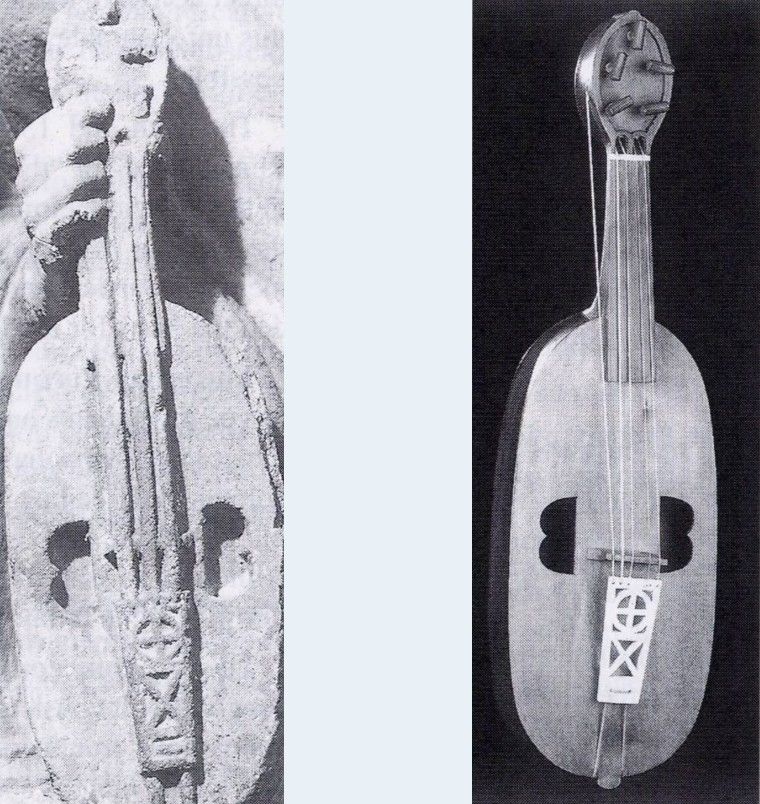Compostela medieval
Porque trobar...

medieval.org
Fonti Musicali fmd 216
1998
1. Lai non par [12:10]
Paris, BN Fr844 “Manuscrit du Roi”
2. Guiraut de BORNÈLH. Reis Glorios [12:04]
Rome, Biblioteca Vaticana, Chigi CV150
3. Guillaume de POITOU. Companho ferai un vers disconvinen [7:02]
Paris, BN, lat 856
4. Eyns ne soy ... Ar ne knuthe [12:28]
London Guildhall
Cantigas de Santa Maria
5. Quen entender quiser, entendedor [3:30]
CSM 130
6. [8:28]
En tamana coita non pode seer ·
CSM 131
Quen leixar Santa Maria ·
CSM 132
Resurgir pode e faze-los seus ·
CSM 133
7. [4:07]
A Virgen en que é toda santidade ·
CSM 134
Aquel podedes jurar ·
CSM 135
8. Poi-las figuras fazen dos santos remenbrança [2:48]
CSM 136
harp prelude [1:42] based on
CSM 123
9. [3:47]
Sempr'acha Santa Maria razon verdadeira ·
CSM 137
Quen a Santa Maria de coraçon ·
CSM 138
10. Maravillosos e piadosos [3:56]
CSM 139
PORQUE TROBAR...
John Wright
Equidad Barès — voix, percussions
Françoise Johannel — harpe, organistrum
Anello Capuano — citoles, luth, percussions
Olivier Cherès — vièle ovale
Francisco Luengo — vièle droite
John Wright, voix — vièle ovale, organistrum

Compostela medieval
Porque Trobar e cousa en que jaz entendemento,
poren quen o faz áo d'aver e de razon assaz...
(Opening line of the Prologue to the Cantigas de Santa Maria).
Trobar,
which broadly means “making a song”, also seems to imply the finding —
and seeking — of a pre-existent ideal form. Similarly, when realising a
working musical instrument based on mediaeval imagery, we are forced to
penetrate beyond the images in order to try to grasp the now-invisible
concrete reality that inspired them.
One name is associated with
the 12th Century Pórtico de la Gloria in Santiago Cathedral, that of
Mateo, Master of the works. We can nonetheless take it for granted that
the actual execution, or even the working out of details, was delegated
to several anonymous sculptors, at least one of whom obviously possessed
intimate knowledge of musical instrument construction. The five-string
oval fiddle in particular (one of the earliest traces of a type of
instrument extremely common throughout the Middle Ages) is represented
no less than eight times on the Pórtico with front, back and side views —
a veritable exhibition.
Even so, we are left with many open
questions. For instance, what was the exact scale of the sculptures and
thus the size of the originals? Is the number of strings correct on the
harps and psalterions? — and of course we have no idea of the materials
used nor plate-thicknesses.
We therefore have to place much reliance
on comparative studies of other documents of all kinds. But when all
comes to all, nothing can replace empirical trial and error; hand and
ear are the best judges, — but in this are we not simply treading in the
footsteps of mediaeval man?
Interpretation problems posed by the
12th and 13th Century songbooks from which Porque Trobar... draws its
repertoire call for a similar blend of factual knowledge and creativity.
Whilst the words may have been written compositions, detail variations
in the tunes lead us to believe that we are dealing with transcriptions
of what was basically oral tradition. In interpreting it we are once
again forced to “read between the lines” referring to our present-day
experience of orally-created music.
Rhythm is a particularly
thorny problem, as sometimes the measure is implicit in the notation,
sometimes not, with many shades between the two extremes. In all cases
it is advisable to base one's choices on the scansion of the text for,
as with present-day oral tradition, music is always servant to the
poetic text. In some ways mediaeval notation has the advantage over
modern transcription in that it gives flexibility in the representation
of a type of music that is always in a permanent state of flux and where
overall structure is the most important thing to grasp, the details of
the notation giving an idea of typical practice rather than direct
orders for interpretation.
We might draw a parallel with the
cahiers de chansons, carefully calligraphed exercise books still very
common in the French countryside. The songs in them are not necessarily
part of a singer's usual repertoire, but seem to be written down for the
beauty of the act. Could this also be true of the mediaeval
chansonniers?
And if it is art we are dealing with, the element
of craftsmanship is never entirely absent from this poetry. Did not
troubadours like Marcabru and Giraut de Bornèlh use the metaphor of
“sharpening- stone and steel” to hone the tools of their trade? One of
the songs in this disc, the Lai non par can be seen as a stylistic model, a template for fin trobar. And it so happens that, without any deliberate intention on our part, a fair number of pieces presented here are anonymous.
Porque
Trobar... dedicates this disc to all those unknown and unsung handlers
of chisel and pen who so brilliantly recorded the intelligence of their
times.
The Gelmirez Project took place in 1993 at the
Musical Instrument Workshop of the Deputation of Lugo in Galicia, Spain
(Obradoiro de Instrumentos Musicáis. Centro de Artesania e Deseño) -
director, Luciano Perez.
The aim was to re-create a number of
working mediaeval stringed instruments as prototypes for subsequent
reproduction at the workshop. Previous research (1988-1992) on the
Pórtico de la Gloria (1188) in Santiago de Compostela Cathedral had
clearly shown that 12th Century instruments were neither primitive or
rustic.
Our approach was to pick out details which seemed to us
to reflect constant parameters governing the working of stringed
instruments in general. In other words to “look for the familiar in the
unfamiliar”. We also studied the possible influence of geometrical
methods for tracing the outlines.
The main focus of our studies
was upon the instruments represented on the corbils (circa 1270) in the
great banqueting hall of the Palacio de Gelmirez at Santiago de
Compostela. We also reproduced a small selection of instruments in the
hands of the Elders of the Apocalypse on the Portico as this seemingly
inexhaustible mine of information provides the key to the understanding
of stringed instruments throughout the Middle Ages.
Francisco
Luengo, Christian Rault and John Wright were responsible for the
research, development and designs of the prototypes, the instruments
being built in the workshop by the permanent workmen, Antonio Franco,
Carlos Galván, Jesús Pérez and Germán Arias.
The result is a unique
collection of working replica instruments which, both visually and
musicnlly, in Galicia and beyond have stimulated the imagination of a
wide and varied audience.
We should add that all the participants
in the Gelmirez project were previously involved in Barrié de la Maza
Foundation project (1988-92) which concentrated entirely on the
reproduction of the instruments on the Pórtico de la Gloria in Santiago
de Compostela Cathedral, scaffolding being especially erected to allow
direct access to the sculptures. Without the essential information
gleaned during this unforgettable experience, the Gelmirez Project
simply would not have been possible.
The 12th and 13th Centuries
have been variously described as “the First Renaissance” or “the First
Industrial Revolution”: our work on the Pórtico and in the Palacio
Gelmirez has more than confirmed this and has convinced us that the
original instruments that inspired the sculptures were the result of
fundamental acoustical and technological research of remarkable quality
which provided the basis for modern lutherie.
The group Porque Trobar...
was formed in 1994 in order to exploit the prototype instruments built
during the Gelmirez Project. All the members, of varying musical
horizons, have in common experience in oral traditional music and this
colours their reading of the musical texts. The arrangement of the music
is a communal effort, the fruit of everyone's capacity for invention
and experiment. Although, as with the development of the instruments, we
were “looking for the familiar in the unfamiliar” there is no attempt
to adapt it to modern tastes.
The repertoire comes entirely from 12th
and 13th Century French and Spanish songbooks. It consists of pieces by
Guiraut de Bornèlh, Guillaume de Poitou and anonymous troubadours;
there are also extracts from the Cantigas de Santa Maria, the famous songbook commanded by Alphonse the Wise.
John Wright

The instruments used in this record were all built as part of the
above-mentioned project. Very little is known about the musical uses
for which these instruments were intended. Due to the hypothetical
nature of our instrumentation, the instruments had to be adapted to suit
our own choice of repertoire. For all the pieces here, the reference
note is D (A = 415Hz). Tunings and intonation are based upon the
Pythagorean scale in accordance with mediaeval theory.
5-string oval fiddles (Pórtico)
These
are offset-drone fiddles. We have adopted the first of the three
tunings given at the end of the 13th Century in the treatise by
Geronimus of Moravia, a Parisian scholar. Transcribed into our key, this
gives A4 - A4 - D4 - D3 - A3. This tuning not only lends itself to
drone playing but also possesses fascinating polyphonic possibilities.
4-string upright “long” fiddle (Gelmirez)
The
instrument in the original sculpture has 3 strings. The neck is broken
off and Francisco has interpreted the instrument as a long necked type
which figures in the Cantigas de Santa Maria miniatures. He has added an
offset drone and tunes the fiddle in several different ways, most often
A3 - D3 and A2 - G2.
Harp (Gelmirez)
This 15-string
harp is very light and fragile and gives a very sweet tone. It is tuned
to a diatonic scale extended to include major and minor sevenths in
accordance with mediaeval theory and practice.
Citoles, 3 & 4-string (Gelmirez)
This
strange instrument type with its “flying buttress” behind the neck, was
in vogue from the 13th Century onwards for a period of only about 200
years. Much research still remains to be done on it. Tuning: the small
4-string instrument C5 - G4 - D4 - A3 and the larger one, A3 - D3 - A2.
3-string lute (Pórtico)
Two
of these instruments are represented on the Pórtico de la Gloria. Their
interpretation poses a number of problems regarding certain details,
especially the belly which could either consist of a wooden plate or a
membrane. Ours has a membrane. Tuning - D4 - A3 - D3.
Organistrum (Pórtico)
This
giant ancestor of the hurdy-gurdy had to be played by two people, one
turning the rosined wheel by means of the handle and the other stopping
the notes with the keys. The organistrum was very likely used as an aid
for composing organa, providing the tenor. Tuning - A3 - E3 - A2.
John Wright

1 • Lai non par — Paris, BN Fr844 (“Manuscrit du Roi”)
Anonymous
piece, probably very early from the troubadour repertoire. Although the
main theme is a pilgrimage to the Holy Land, the principal motifs of
troubadour expression are present - the lady, the jealous husband, the
slanderers, the state of joy, etc. Lays are generally admitted to be a
Breton (or British) genre; certain rhythm patterns suggested by the
scansion of the text, plus passing allusions to Arthurian legend,
certainly lend weight to this notion.
Finely and joyously I begin for you a lay without compare...
A joyful tune for the Lady that the lover is about to leave behind. It
is the duty of every nobleman to undertake a journey to the Holy Land.
Although he must serve through suffering, the thought of the Noble Lady
gives him strength, courage and peace. And amid the bitter groans of
jealous husband, he sets out for the River Jordan. His prayers go forth
to the Saviour for the pardon of his sins and that he might return to
the castle of Blanchefleur, to his beloved.
2 • Reis Glorios... Guiraut de Bornèlh (...1162-...1199). Rome, Biblioteca Vaticana, Chigi CV150.
Alba
or “dawn call”. The dialogue takes place between a man keeping a
lookout for his friend who is spending the night with his lady. The
refrain And soon it will be dawn... is a warning not to tarry too long.
This setting has been conceived to set off each individual instrument as in turn they take the prelude to each verse.
The
watchman begs the Glorious King (of Heaven) to lend aid to his fine
companion. He tells the latter to sleep no longer, for the star
heralding the dawn is rising in the East, the bird is singing in the
bush and he fears that the “jealous one” will get him. He assures him
that he has not risen from his knees all night praying for his safe
return. The lover answers that he holds and embraces the fairest one
ever born of mother and he cares not for the jealous madman nor the
dawn.
3 • Companho farai un vers disconvinen... Guillaume de Poitou, 9th Duke of Aquitania (1071-1126). Paris, BN, lat 856.
The
music, which incorporates this text in Latin, is to be found in the
Saint-Martial manuscript (BN, lat. 1139) associated with the conductus, Promat chorus hodie, o contio. Certain similarities with the Reis Glorios tune suggest a common origin which is why we have juxtaposed the two pieces.
Companions,
I'm going to make a rude song, and in it there will be more folly than
sense. And you can call him a boor that does not understand it...
Comparing two horses, both of great worth and whose qualities he vaunts,
the problem being that he cannot keep them together as they cannot
stand each other, the singer asks for advice on the choice he must make
between...Lady Agnes and Lady Arsene!
The musicians here improvise “horse” interludes.
4 • Eyns ne soy... / Ar ne kuthe... Anonymous London Guildhall.
The
song of a prisoner, in Anglo-Norman French, followed by a translation
in Middle English on the same page of the manuscript, (12th Century?).
Both versions are sung successively here separated by a musical dialogue between harp and 4-stringed citole.
The
singer implores Jesus Christ, truth of God, truth of Man, to free him
from the prison in which he and his companions have been thrown without
reason, living in anguish and shame. Mad is he who trusts in this mortal
life and believes he can escape from trickery. Now we are in joy, now
in sadness; now fickle Fortune brings a remedy, now it wounds us. May
the Maiden that bore the Heavenly King beseech her son, that sweet thing
to free us from the evil one and bring us out of this place.
Cantigas de Santa Maria, 130 - 139.
From
the famous 13th Century songbook in Gallego-Portugese commissioned and
supervised by the King Alphonso X, “the Wise”. Over 400 songs with their
tunes are grouped together in this songbook (which exists in three
versions) recounting the miracles of the Virgin Mary. They are grouped
in sequences of ten, each set beginning with a hymn to the Virgin. We
present here a whole sequence of tunes in numerical order, some sung
with extracts from the texts, whilst others are instrumentals.
5 • Cantiga 130: Sung cantiga. This is in praise of Saint Mary accompanied by the organistrum.
Whoever wishes to know, should be knowledgeable of the Mother of our Lord.
6 •
Cantiga 131: Sung cantiga, prelude by the 4-string citole.
This
is about how Saint Mary saved the Emperor of Constantinople from being
crushed under a falling rock, and how all of the rest who were with him
died.
Cantiga 132: Sung cantiga.
This is about how Saint Mary made a priest, who had promised her chastity but married instead, leave his wife to serve only Her.
Cantiga 133: Instrumental dialogue.
This is about how Saint Mary brought back to life a young girl who had been lain dead before her altar.
7 •
Cantiga 134: Oval fiddle solo with tambourine accompaniment.
This
is about how Saint Mary in her church in Paris gave shelter to a man,
and many others who were with him, who had cut off his leg because of
the great pain he had of Saint Martial's fire.
Cantiga 135: Sung cantiga, prelude by the harp, based on the Cantiga 123 [sic; the prelude is in track 8, Cantiga 136]
How
Saint Mary kept from deshonour a young couple who had sworn by her when
they were children that they would marry one another, and how she made
them keep their promise.
8 • Cantiga 136: Harp/citole duet.
This
is about how in the Land of Pulla, in a village called Foia, a woman
was playing dice outside a church with her friends, and since she lost,
she threw a stone, which was going to hit the Child held by Saint Mary
who raised her arm and received the blow herself.
9 •
Cantiga 137: Sung cantiga.
How Saint Mary made a gentleman, who had been full of lust, chaste.
Cantiga 138: Instrumental tutti.
How
Saint Joan Boca-d' ouro, because he praised Saint Mary, had his eyes
gouged out and was exiled and stripped of his patriarchate; and then
Saint Mary returned his sight, and through her he earned his divinity.
10 • Cantiga 139: Sung cantiga.
How Saint Mary made the Son in her arms speak to the child of the good woman who had said “to eat”

Remerciements
Jeff Barbe
Bernard Ménétrier
Catherine Perrier
Keith Ammerman
Centro Galego de Bruselas
lieu d'accueil et de rencontres toujours ouvert aux projets culturels.
Unidad de Diseño C.A.D.G.
pour les idées de presentation et pour les documents de la couverture.
Photos
Obradoiro Instrumentos Musicáis
John Wright
fonti musicali, Bruxelles
Porque Trobar..., Paris
Obradoiro Instrumentos Musicáis, Lugo
Enregistrement:
Lou & Claude Flagel
NAGRA Digital
Micros: Bruel & Kjxr
Mastering: Sonic Solution
Local: The Right Place, Bruxelles.
1998
Patrocinado por:
Centro de Artesanía e Deseño de Galicia
Deputación Provincial de Lugo






